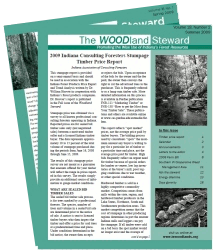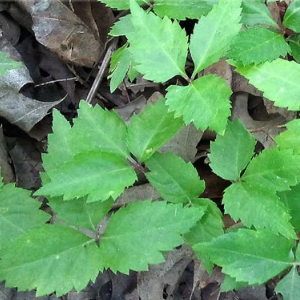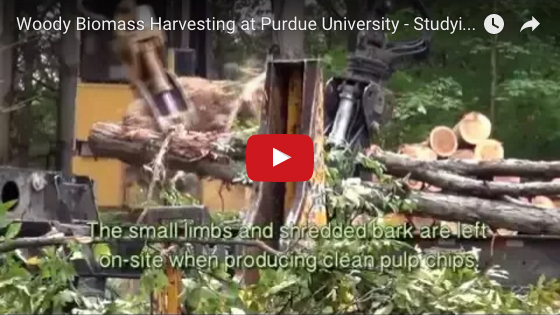 Purdue University - Extension - Forestry and Natural Resources
Purdue University - Extension - Forestry and Natural Resources
Got Nature? Blog
Issue:
Woodlands provide a multitude of environmental (e.g., carbon sequestration, enhance water quality, wildlife habitat), economic (e.g., timber, wood products manufacturing, tourism), and social (e.g., recreation, aesthetics) benefits to Indiana residents. The sustainability of these benefits is strongly tied to stability of the resource. In Indiana, 75 percent of the 4.65 million acres of forestland is owned by families. Actions they take on their property can impact the benefits woodlands provide all Indiana residents. However, many do not understand available options or sources of assistance.
What Has Been Done:
 The Department of Forestry and Natural Resources, in partnership with many other organizations, helps produce and mail over 31,000 copies of the Indiana Woodland Steward to woodland owners three times each year. This 16-page, two-color publication includes in-depth articles on forest stewardship and health, invasive species and pests, wildlife habitat management, economics, and more.
The Department of Forestry and Natural Resources, in partnership with many other organizations, helps produce and mail over 31,000 copies of the Indiana Woodland Steward to woodland owners three times each year. This 16-page, two-color publication includes in-depth articles on forest stewardship and health, invasive species and pests, wildlife habitat management, economics, and more.
Results:
Subscribers owned more woods (71.6 ac) for a longer tenure (33 years) than the average woodland owner in Indiana based on data from the National Woodland Owner Survey. As a group, they were also more active managers based on the proportion enrolled in assistance programs and who had a written stewardship plan. Fifty-four percent regularly utilized information from the Woodland Steward. In addition, 51 percent of respondents have implemented at least one practice they read about from The Woodland Steward, potentially impacting an estimated 1.2 million acres of forestland. His use of print media to communicate with woodland owners could be considered expensive, but clearly a large number of woodland owners regularly read and utilize the information making the average investment per landowner much lower.
 Forest farming in North America is becoming a popular practice that provides short-term income for owners of new forest plantations while their trees reach maturity. This income diversification is particularly relevant for many of the Indiana hardwood plantations planted in the last decade, but will not fulfill their economic potential until 60–70 years from establishment. This free download publication titled Costs and Returns of Producing Wild-Simulated Ginseng in Established Tree Plantations, FNR-530-W, is the second in a two-part series aimed at analyzing economic opportunities in forest farming for Indiana forest plantation owners. The first study explores growing hops along the tree line of newly established forest stands, while this second study investigates producing American ginseng in older (20- to 30-year-old) forest plantations.
Forest farming in North America is becoming a popular practice that provides short-term income for owners of new forest plantations while their trees reach maturity. This income diversification is particularly relevant for many of the Indiana hardwood plantations planted in the last decade, but will not fulfill their economic potential until 60–70 years from establishment. This free download publication titled Costs and Returns of Producing Wild-Simulated Ginseng in Established Tree Plantations, FNR-530-W, is the second in a two-part series aimed at analyzing economic opportunities in forest farming for Indiana forest plantation owners. The first study explores growing hops along the tree line of newly established forest stands, while this second study investigates producing American ginseng in older (20- to 30-year-old) forest plantations.
Resources:
Costs and Returns of Producing Wild-Simulated Ginseng in Established Tree Plantations, The Education Store, Purdue Extension’s resource center
Energy Requirements for Various Tillage-Planting Systems, The Education Store
Home Gardner’s Guide, The Education Store
Common Tree and Shrub Pests of Indiana, The Education Store
Planting Forest Trees and Shrubs in Indiana, The Education Store
Kim Ha, Research Assistant
Purdue Agricultural Economics
Lenny Farlee, Sustaining Hardwood Extension Specialist
Purdue Department of Forestry and Natural Resources
 Biomass harvesting refers to harvesting where more woody material is gathered than in a traditional sawtimber harvesting. Material down to four inches in diameter is harvested along with large trees for veneer logs and saw logs. Small trees and tops are chipped and used for paper pulp and boiler fuel.
Biomass harvesting refers to harvesting where more woody material is gathered than in a traditional sawtimber harvesting. Material down to four inches in diameter is harvested along with large trees for veneer logs and saw logs. Small trees and tops are chipped and used for paper pulp and boiler fuel.
During October of 2012, a biomass harvesting project was started by harvesting a 100 acre tract of hardwood timber at the Southeastern Purdue Ag Center (SEPAC). The tract was divided into several treatment areas demonstrating various forms of harvesting including traditional clearcutting, biomass harvesting, and areas left uncut. The goal of this project was twofold: to determine the volume and value of the products produced using biomass harvesting compared to the traditional methods, and to gain a more thorough understanding of what happens to a harvest site following biomass harvesting when restoration practices are used.
The harvest site has experienced a rapid recovery of new vegetation. Forbs, shrubs, tree seedlings, and sprouts densely covered the ground and began providing new wildlife habitats and the beginnings of a new diverse forest area.
The new Extension video “Woody Biomass Harvesting at Purdue University” explores this process in further depth, showing the harvest as well as the aftermath and regrowth. It also introduces a Purdue Extension – FNR developed web application called the Woody Biomass Calculator. This calculator can be used by landowners, foresters, and wood products harvesters and managers to estimate the volume and value of several different wood product groups and tree species, including woody biomass. Before harvesting, consider using this tool to evaluate if biomass harvesting is a better choice than traditional sawtimber harvesting for you.
Resources:
Woody Biomass Harvesting at Purdue University – Studying the Advantage Over Traditional Harvesting – Purdue Extension
Woody Biomass Calculator – Purdue Extension – FNR
Harvesting Biomass: A Guide to Best Management Practices – IDNR Division of Forestry
Woody Biomass Feedstock for the Bioenergy and Bioproducts Industries – IDNR Division of Forestry
IN Wood Industry Facts – Purdue FNR Wood Research Laboratory
Lenny Farlee, Sustaining Hardwood Extension Specialist
Purdue University Department of Forestry and Natural Resources
Forests and woodlots are constantly changing. To get the most out of your property to meet your wildlife, recreational, aesthetic or economic goals, some type of regular management will be necessary. Getting the most out of your woods can be a challenge on your own. Fortunately, there are many resources available to help you.
A professional can help plot the best course of action for meeting your ownership objectives while keeping your woods healthy. Your selection of a professional depends on what services you need and the size of your property. Ten (10) acres is a threshold for where you go in Indiana.
More than 10 acres
- The Directory of Professional Foresters is a service provided by the Indiana Forestry & Woodland Owners Association. For this directory, the term “professional forester” means a person who has successfully completed a four year college level curriculum accredited by the Society of American Foresters and has received a Bachelor’s Degree in Forestry from that accredited institution.
- The Indiana DNR Division of Forestry provides private forestland management assistance through District Foresters who are professionally trained to manage forestland for the many resources it can provide. District foresters administer both state and federal programs that provide technical assistance, property tax incentives, and cost-sharing incentives for applying practices that accomplish sustainable management.
- Foresters can help answer some of your tax questions. The National Timber Tax Website is another good resource. The National Timber Tax Website was developed to be used by timberland owners, as well as a reference for accountants, attorneys, consulting foresters and other professionals who work with timberland owners regarding the tax treatment of timber related activities.
Less than 10 acres and Backyards
- The Indiana Division of Forestry has a woodlot owner series that provides basic information for anyone who owns a small woodlot or backyard woods.
- Because of the scale of operation, it can be difficult to get professional services from a forester for small woodlots. In most cases, tree harvests and other improvement cuts are set up directly with loggers. The Indiana Hardwood Lumberman’s Association has a Find a Logger database online.
Selling Timber
Selling timber from yards or small tracts of woodland present some challenges.
- Three Purdue publications provide suggestions on steps to take when selling timber:
Marketing Timber, The Education Store, Purdue Extension Resource Center.
Tips on How to Get the Most from Your Timber Harvest, The Education Store. - Some consulting and industrial foresters may be willing to assist you on small properties. Find foresters in your area at: www.findindianaforester.org.
- In some cases, tree harvests are conducted directly with loggers. The Indiana Hardwood Lumberman’s Association has a Find a Logger database online.
Forest Management for the Private Woodland Owner Course
The Forest Management for the Private Woodland Owner course provides forest landowners eight learning sessions designed to introduce them to the biology and management of forests, and the resources and professional assistance they can access to help them form their property management goals and pursue their objectives. Field experiences are integrated into the course to provide in-person, hands-on connections with the biology and management of Indiana forests. Connections made during the course and field tours introduce landowners to the foresters and other natural resource professionals who can help them with the management of their forestland. This course is offered in-person at varying locations around the state and also as an online version with live question-and-answer sessions. Courses normally run between January and April, so check the Purdue Extension – FNR Got Nature Blog and Upcoming Events sites for dates and registration information.
Get connected with other Indiana landowners!
Woodland owners often learn the most from people who are in their situation – fellow woodland owners. Several groups provide different ways to connect and have different resources. Explore the following to find out which group(s) fits your needs.
- Indiana Chapter, American Chestnut Foundation
- Indiana Forestry & Woodland Owners Association
- Indiana Tree Farm Program
- Indiana Woodland Steward Institute, Inc.
- Walnut Council
Invasive Species
Invasive species present a serious threat to the health and productivity of trees and forests. You can learn about recognition, reporting, and management of the invasive species found in forests at these sites:
- Purdue University Report Invasives
- Purdue FNR Got Nature Blog post, What Are Invasive Species and Why Should I Care?
- Indiana Invasive Species Council
Forestry Videos on Purdue Extension – FNR YouTube Channel
- Forests and Timber Playlist
- Invasive Species Playlist
- ID That Tree Playlist
- Subscribe to Purdue Extension – Forestry & Natural Resources (FNR) YouTube Channel and receive notice of when a new video is posted.
Recent Posts
- HTIRC Continues to Protect Our Hardwood Forests
Posted: April 18, 2025 in Forestry, Timber Marketing, Woodlands - Liz Jackson Receives IHLA’s President’s Award, Featured in ANR Newsletter
Posted: April 17, 2025 in Forestry, Timber Marketing, Wildlife, Wood Products/Manufacturing, Woodlands - Tax Information For Woodland Owners
Posted: January 30, 2025 in Forestry, How To, Timber Marketing, Woodlands - IDNR Offers Program Aiding in Property Tax Reductions – IFWOA
Posted: January 25, 2025 in Forestry, Timber Marketing, Wood Products/Manufacturing, Woodlands - Announcing-New Indiana Woodland Steward Newsletter
Posted: December 19, 2024 in Forestry, Timber Marketing, Wildlife, Woodlands - Purdue Extension’s Showcase, Impacting Indiana
Posted: November 8, 2024 in Community Development, Forestry, Forests and Street Trees, Gardening, Land Use, Natural Resource Planning, Timber Marketing, Urban Forestry, Wildlife, Wood Products/Manufacturing, Woodlands - New Indiana Woodland Steward Newsletter, Your Forest and Wildlife Resource
Posted: May 7, 2024 in Timber Marketing, Wildlife, Woodlands - Natural Resources University Podcasts Earn ANREP Gold Award
Posted: April 14, 2023 in Podcasts, Ponds, Timber Marketing, Wildlife, Woodlands - 100 Year Project Newsletter, Hardwood Ecosystem Experiment (HEE)
Posted: March 8, 2023 in Forestry, Timber Marketing, Wildlife, Woodlands - Forest Landowners Will Want to View U.S. Forest Service Resource
Posted: February 9, 2023 in Forestry, How To, Timber Marketing, Woodlands
Archives
Categories
- Alert
- Aquaculture/Fish
- Aquatic/Aquaculture Resources
- Ask the Expert
- Christmas Trees
- Community Development
- Disease
- Drought
- Forestry
- Forests and Street Trees
- Gardening
- Got Nature for Kids
- Great Lakes
- How To
- Invasive Animal Species
- Invasive Insects
- Invasive Plant Species
- Land Use
- Natural Resource Planning
- Nature of Teaching
- Plants
- Podcasts
- Ponds
- Publication
- Safety
- Spiders
- Timber Marketing
- Uncategorized
- Urban Forestry
- Webinar
- Wildlife
- Wood Products/Manufacturing
- Woodland Management Moment
- Woodlands
